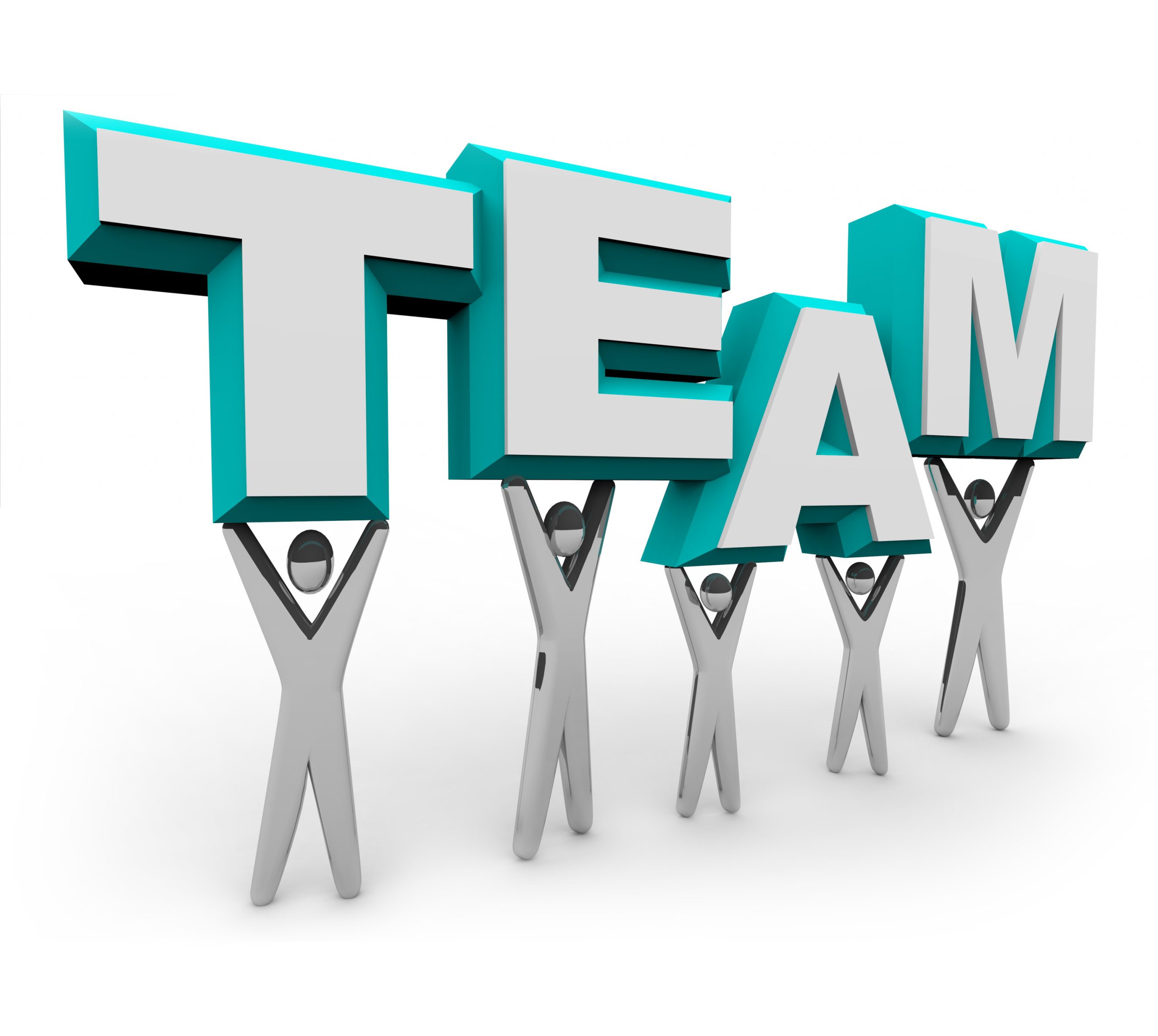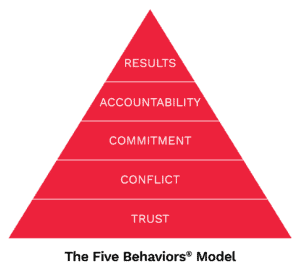Enhancing Team Dynamics and Performance Through the Five Behaviours Model
by Mike Mack
In today’s fast-paced work environment, effective teamwork is more important than ever. Teams are the backbone of any organization, driving innovation, collaboration, and results. However, many teams struggle with dynamics that inhibit their potential. This is where the Five Behaviours model comes into play. This training model, developed from Patrick Lencioni’s famous book, “The Five Dysfunctions of a Team,” focuses on building a cohesive team by emphasizing five key behaviours that enhance collaboration and performance. Let’s explore the Five Behaviours model and how it can transform your team dynamics.
Understanding the Five Behaviours Model
The Five Behaviours model is based on the principles of teamwork and provides a structured approach to improving team dynamics. The five behaviours outlined in the model are displayed as a pyramid intentionally – it is difficult to sustain achievement for higher-level items until a solid foundation is first built.
These behaviours are interconnected and build upon one another to create a foundation for effective teamwork. Let’s look closer at each behaviour and understand its significance.
- Trust
Trust is the cornerstone of any successful team. It creates an environment where team members feel safe to express their thoughts, ideas, and concerns without fear of judgment or repercussion. When trust exists within a team, members are more likely to take risks and engage in open conversations, leading to more innovative solutions and effective collaboration.
Building trust requires vulnerability. Team members must be willing to share their weaknesses, mistakes, and uncertainties. This openness creates a bond that encourages mutual support and understanding. Regular team-building activities and transparent communication can help establish this crucial foundation of trust.
- Conflict
While conflict may seem counterproductive, healthy conflict is essential for a team’s growth and development. When team members feel secure in their relationships, they are more willing to engage in constructive debates and discussions. This openness can lead to innovative ideas and solutions as different perspectives are considered.
The key is to approach conflict with a mindset of curiosity rather than defensiveness. Teams should establish norms for how to handle disagreements respectfully and constructively. Encouraging open dialogue and emphasizing the importance of diverse opinions can help teams navigate conflict in a way that strengthens their cohesion.
- Commitment
Commitment arises when team members are aligned and dedicated to the team’s goals. After engaging in open discussions and addressing conflicts, team members should feel a sense of ownership over the decisions made. This commitment fuels motivation and drives individuals to contribute their best efforts towards achieving the team’s objectives.
To create commitment, it’s crucial for teams to clarify their goals and roles. When everyone understands their responsibilities and how their work contributes to the larger mission, they are more likely to be invested in the team’s success. Regular check-ins and updates can reinforce this commitment, ensuring that everyone remains aligned and engaged.
- Accountability
Accountability is about taking responsibility for one’s actions and commitments. In a team environment, this means that members hold each other accountable for their contributions and performance. A culture of accountability encourages individuals to take ownership of their work and strive for excellence.
To promote accountability, teams should establish clear expectations and performance metrics. Regular feedback sessions can provide opportunities for constructive discussions around progress and areas for improvement. When team members feel empowered to hold one another accountable, it enhances overall performance and fosters a sense of shared responsibility.
- Results
The ultimate goal of the Five Behaviours model is to achieve tangible results. A cohesive team that embodies trust, engages in healthy conflict, commits to shared goals, and holds each other accountable is well-positioned to deliver exceptional outcomes. Results are not just about meeting targets; they also encompass team satisfaction and engagement.
To focus on results, teams should celebrate successes and learn from failures. Recognizing achievements boosts morale and reinforces the importance of collective effort. Teams should also regularly assess their performance against established goals to ensure they remain on track and adjust their strategies as needed.
Implementing the Five Behaviours Model in Your Team
To successfully integrate the Five Behaviours model within your organization, start by assessing your team’s current dynamics. Conducting a survey or utilizing team assessments can help you identify strengths and areas that need improvement. This initial evaluation provides valuable insights into the existing levels of trust, conflict management, commitment, accountability, and results orientation.
Creating an environment that promotes open discussions is essential. Regular team meetings should focus on addressing challenges, celebrating successes, and identifying opportunities for growth. Encouraging team members to share their perspectives builds trust and openness, setting a solid foundation for collaboration.
Setting clear, measurable goals collaboratively is another important step. When every team member understands their role in achieving these goals and how their contributions align with the team’s objectives, it promotes a sense of commitment and motivation. Clarity in purpose drives engagement and reinforces individual accountability.
Encouraging constructive conflict is vital for growth. Training team members on how to engage in healthy debates can significantly improve dynamics. Establishing guidelines for respectful communication and conflict resolution helps create a safe space for discussions. Role-playing scenarios may also provide practical experience in navigating disagreements effectively.
Implementing accountability practices is key for fostering ownership among team members. Developing a system that includes regular progress check-ins, peer feedback sessions, and performance reviews can help hold individuals accountable for their commitments. Creating a culture where team members feel comfortable discussing challenges and seeking support is crucial for maintaining high standards.
Recognizing and celebrating both individual and team achievements is important for morale. Acknowledging successes reinforces the significance of collective effort and motivates team members to strive for excellence. Implementing a recognition program can be an effective way to highlight outstanding contributions and create a sense of accomplishment.
Establishing a culture of continuous improvement is essential for long-term success. Regularly evaluating team performance and dynamics allows you to gather feedback on what is working well and what could be enhanced. Being open to making adjustments based on this feedback will help create a more effective team environment, ensuring that the Five Behaviours model is not just a one-time initiative, but an ongoing commitment to growth and collaboration.
As an award-winning Wiley partner, our X5 Management team includes several facilitators trained in delivery of the Five Behaviours model. We would welcome the opportunity to discuss how we can bring this training to your workplace to Align Your Leaders and Teams to Achieve.
Conclusion
The Five Behaviours model offers a powerful framework for enhancing team dynamics and performance. By building trust, encouraging healthy conflict, cultivating commitment, implementing accountability, and focusing on results, organizations can create cohesive teams that drive success. Embracing these behaviours not only improves team performance but also nurtures a positive organizational culture that supports growth and innovation.
As organizations navigate the complexities of today’s work environment, investing in the development of effective teamwork through the Five Behaviours model can yield significant returns, paving the way for sustained success and achievement.
About the Author: Mike Mack, President
Mike Mack is a sought-after Executive Coach, Consultant, Facilitator and a three-time Amazon bestselling author. He has been 
Mike and his colleague Kris Schinke collaborated to write a book on retaining employees, which was published in October 2023; HOW TO STOP THE REVOLVING DOOR – 5 Strategies that will Positively Impact your Employees and Business Results.
Exclusive Insights for Growth—Join Our Newsletter!





